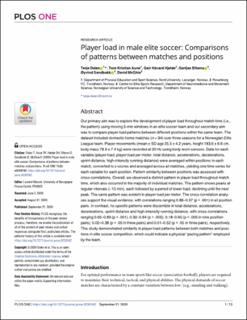| dc.description.abstract | Our primary aim was to explore the development of player load throughout match time (i.e., the pattern) using moving 5-min windows in an elite soccer team and our secondary aim was to compare player load patterns between different positions within the same team. The dataset included domestic home matches (n = 34) over three seasons for a Norwegian Elite League team. Player movements (mean ± SD age 25.5 ± 4.2 years, height 183.6 ± 6.6 cm, body mass 78.9 ± 7.4 kg) were recorded at 20 Hz using body-worn sensors. Data for each variable (player load, player load per meter, total distance, accelerations, decelerations, sprint distance, high-intensity running distance) were averaged within positions in each match, converted to z-scores and averaged across all matches, yielding one time series for each variable for each position. Pattern similarity between positions was assessed with cross-correlations. Overall, we observed a distinct pattern in player load throughout match time, which also occurred in the majority of individual matches. The pattern shows peaks at regular intervals (~15 min), each followed by a period of lower load, declining until the next peak. The same pattern was evident in player load per meter. The cross-correlation analyses support the visual evidence, with correlations ranging 0.88–0.97 (p < .001) in all position pairs. In contrast, no specific patterns were discernible in total distance, accelerations, decelerations, sprint distance and high-intensity running distance, with cross-correlations ranging 0.65–0.89 (p < .001), 0.32–0.64 (p < .005), 0.18–0.65 (p < .005 in nine position pairs), 0.02–0.38 (p < .05 in three pairs) and 0.01–0.52 (p < .05 in three pairs), respectively. This study demonstrated similarity in player load patterns between both matches and positions in elite soccer competition, which could indicate a physical “pacing pattern” employed by the team. | en_US |

